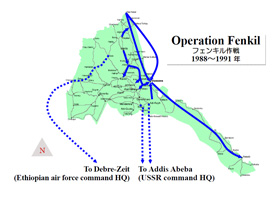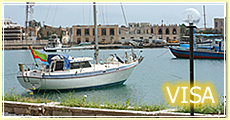マッサワ港とダハラック諸島(ナクラ)にある旧ソ連の核基地を陸海空から守備ために70~80kmにわたって伸びる全ての集中的防衛線もまた、英雄たちの手に落ち、マッサワ港は解放された。この戦闘と振動は、東アフリカを巻き込んだ。そのため、ワシントンとモスクワは、電話でのホットラインを敷かなくてはならなくなった。超大国の外交圧力が激化した。解放されたマッサワ港とその周辺地域には、紅海沖合いに停泊した旧ソ連の軍艦から発射されたスカッドミサイルが数週間に渡って降りそそいだ。にもかかわらず、EPLAの兵士たちは(その30%は女性兵士であった)断固として退かず、“紅海の真珠”と呼ばれたマッサワの街を自由の震源地とした。
同じ年に、北部からはじまりマッサワ港までつらなる1200kmの長いEPLAの行軍は、アッサブ(エリトリア南部の港湾都市)とアディスアベバ(エチオピアの首都)のry9応報における敵軍の司令部に向かい、一方でまた、1500kmにも及ぶ行軍がデブレゼイト(Debrezeit:エチオピアの主要な空軍基地、司令基地)へ向かった。EPLAは東アフリカ情勢を書き換え、この地域の兄弟のような人々の間における連帯や協力の一里塚を築いた。
1993年には、このフェンキル作戦により、東アフリカでのテロリズムの銃声は止むに至った。その結果、エリトリアとエチオピアの人々は解放された。フェンキル作戦は、あらゆる人種や信念を持ち先見の明のある人々の真実のための同情や実証の献身的な連鎖であり、現在は、毎年、エリトリアのマッサワ港において2月に祝福されている。
Historic step on the long march to freedom – “Operation Fenkel 1988 – 1991”:
Bruno: Tokyo February 9, 2011
On August 1988, after a heroic and protracted defensive war of wear and tear, between the USSR lead army of Ethiopia and Eritrea, which was carried out in the ranges of the (Nakfa) Sahel mountains and its environs for a decade, Eritrean peoples Liberation army (EPLA) made a decisive strategic offensive to occupy a major front surrounding the town of Afabet (Sahel).
Afabet is strategic town, which hosted the master minds of the war, i.e. Soviet and their allies’ command station. It is located south of the mountains of Sahel. It is also a gateway as well as a trade corridor to the agricultural and resource rich west and the eastern lowlands of Eritrea.
Wuchu, a veteran army commander in the EPLA, announcing the start-up of the offensive to his division named this battle an “open-end invitation to the funeral”. Basil Davidson, British historian who witnessed the battle named it “Second Diem Bien Phu”. Both agree that the success of this historic initiative shall change, once and for all, the gravity of the military landscape in the Horn of Africa.
This battle heralded and opened a new momentum and opportunity, for EPLA, to use mechanized, infantry, naval coordinated firepower and experience. All the lessons accumulated in the past thirty year’s war history, including but not excluding the outstretched elite commando forces capability outside the perimeter of these battle events, were effectively and innovatively used as an instrument to win this historic battle decisively. The offensive was unanimously welcomed and supported by the local population in Eritrea and abroad. Ethiopian army, navy and air force mutinied and were unfortunately mercilessly crashed by their commanders (USSR and their allies).
In 1989, EPLA engaged the remaining heavily armed enemy. It continuously stretched itself on the coastal lowlands to effectively and fully control the Red Sea coast and adjacent Islands. The life-line to the USSR backed Ethiopian army, Massawa – Asmara – Addis Abeba road corridor; fell into the hands of EPLA. All attempts to recover this post by the enemy forces were once and all frustrated.
In 1990, all concentric defensive lines of the enemy, armed to the teeth, stretching for about 80 to70 kms, guarding the Port of Massawa and the Soviet nuclear post in Dahlak (Nakura) from land, sea and air, were also again painted with pictures of heroism. Port of Massawa was freed. The battle and its vibration engulfed East Africa. It induced Washington and Moscow telephone hotline to go operational. Diplomatic pressures of superpowers were intensified. Skud missiles rained in the freed Massawa Port and its environs fired from a distant USSR ships anchored on the Red Sea for weeks. EPLA which was composed of men and women fighters stood stead-fast and made Massawa (“Pearl of the Red Sea”) - the epicenter of freedom. 30% of the fighting forces were women.
In the same year, the long march of EPLA flanked from the north, covering a distance of about 1200 kms from the Port of Massawa started homing to the main command headquarters of the enemy both in Assab (Eritrea southern port city), Addis Abeba (Capital of Ethiopia) and they also flanked from the west another distance of about 1500kms from the Port of Massawa homing to the headquarter of Debrezeit (Main Air force base and headquarter of Ethiopia). EPLA took the entire East Africa in its canvas and painted a picture of heroism, putting another milestone of solidarity and cooperation between the brotherly people of the region.
In 1993, the guns of terrorism were silenced in East Africa by “Operation Fenkel”. The people of Eritrea and Ethiopia were freed as a result of it. “Operation Fenkel”: a dedicated wave of compassion and demonstration for truth by people which included visionaries of every race and creed is celebrated with great honor every year, February, in the Port of Massawa Eritrea.














